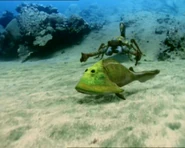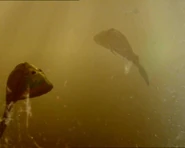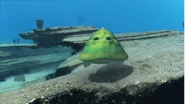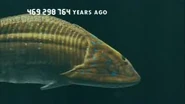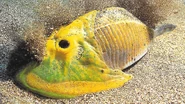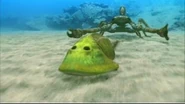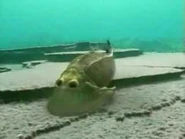Cephalaspis was a prehistoric jawless fish the size of a modern trout.
Facts[]
Cephalaspis was a member of the Osteostraci, one of the most advanced sorts of Paleozoic armored jawless fish. They were scavengers and bottom-feeder, unable to bite, instead feeding on worms, algae, and small shellfish on the sea-floor by sucking them into their jawless mouths utilizing water pressure; they would have also been prey for the large arthropods of her time, including the thunder-scorpion Brontoscorpio and sea "scorpions" (i.e., eurypterids). They lived during the late Silurian period, roughly 400 MYA.
To escape from being eaten, these fish had evolved an early warning system: special sensors on their skin detected even the tiniest vibrations in the water - it would become the lateral line system in the modern fish. But when Cephalaspis detected danger and were already swimming away from it, with their defensive headgear, they couldn't swim fast for long. They had to rest frequently, or they'd tire completely very quickly.
When breeding season came, Cephalaspis congregated to head for the one place they could escape the scorpions: fresh water, inland, with their convoy plowing upriver, away from the sea. They returned to the spawning grounds where they hatched, using memory. Their toughened head had a vital weapon, one of the first complex brains, which is much more developed than their rivals who had no memory at all. This brain allowed Cephalaspis and other early vertebrates to process the information surrounding them that they received from their senses (and the lateral line system) and to escape from dangerous predators, such as the giant Pterygotus.
In the series[]
Walking with Monsters[]
Water Dwellers[]
Cephalaspis appeared in the first episode. Several were seen swimming away from a Brontoscorpio. One was feeding until a Brontoscorpio appeared. It changed direction when it detected a Pterygotus underneath the seabed and escaped while the Brontoscorpio got captured and eaten. Later, a large shoal of Cephalaspis was seen swimming to their spawning grounds further inland. In the process, several were killed by a group of Brontoscorpio, that came across them by luck.
At the end, one Cephalaspis is seen evolving into a Hynerpeton. This is incorrect, as Cephalaspis was a jawless fish which had already separated from the ancestors of Hynerpeton.
Gallery[]
External links[]
- http://en.wikipedia.org/wiki/Cephalaspis
- http://www.britannica.com/EBchecked/topic/103007/Cephalaspis

